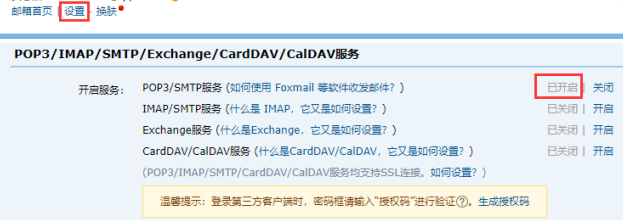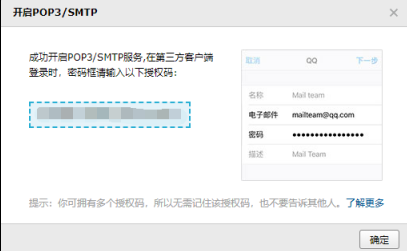在开发中,经常会碰到Email邮件发送的场景,如注册,找回密码,发送验证码,向客户发送邮件,通过邮件发送系统情况,通过邮件发送报表信息等等,实际应用场景很多。
首先介绍以下与发送接受邮件相关的一些协议:
1.发送邮件:SMPT、MIME,是一种基于"推"的协议,通过SMPT协议将邮件发送至邮件服务器,MIME协议是对SMPT协议的一种补充,如发送图片附件等。
2.接收邮件:POP、IMAP,是一种基于"拉"的协议,收件人通过POP协议从邮件服务器拉取邮件。
邮件发送需要的配置
因为各大邮件都有其对应安全系统,我们必须要拿到其对应的客户端授权码才行,在项目中配置SMTP服务协议以及主机配置账户,就可以在项目中使用各大邮件运营商进行发送邮件了。
由于国内使用QQ邮箱的用户较多,所以这里选择QQ邮箱为例。具体要登录QQ邮箱,点击设置、账户选项,向下拉选择开启POP3/SMTP服务

点击开启后会进入验证过程,根据引导步骤发送短信,验证成功后即可得到自己 QQ 邮 箱的客户端授权码了,如图 所示。

<project xmlns="http://maven.apache.org/POM/4.0.0"
xmlns:xsi="http://www.w3.org/2001/XMLSchema-instance"
xsi:schemaLocation="http://maven.apache.org/POM/4.0.0 http://maven.apache.org/xsd/maven-4.0.0.xsd">
<modelVersion>4.0.0</modelVersion>
<groupId>com.email</groupId>
<artifactId>sendemail</artifactId>
<version>0.0.1-SNAPSHOT</version>
<parent>
<groupId>org.springframework.boot</groupId>
<artifactId>spring-boot-starter-parent</artifactId>
<version>2.0.0.RELEASE</version>
<relativePath /> <!-- lookup parent from repository -->
</parent>
<properties>
<!-- 声明项目配置依赖编码格式为 utf-8 -->
<project.build.sourceEncoding>UTF-8</project.build.sourceEncoding>
<project.reporting.outputEncoding>UTF-8</project.reporting.outputEncoding>
<fastjson.version>1.2.24</fastjson.version>
</properties>
<dependencies>
<!-- 引入模板引擎. -->
<dependency>
<groupId>org.springframework.boot</groupId>
<artifactId>spring-boot-starter-thymeleaf</artifactId>
</dependency>
<dependency>
<groupId>org.springframework.boot</groupId>
<artifactId>spring-boot-starter-mail</artifactId>
</dependency>
<dependency>
<groupId>org.springframework.boot</groupId>
<artifactId>spring-boot-starter-web</artifactId>
</dependency>
<dependency>
<groupId>org.springframework.boot</groupId>
<artifactId>spring-boot-starter-test</artifactId>
<scope>test</scope>
<exclusions>
<exclusion>
<groupId>org.junit.vintage</groupId>
<artifactId>junit-vintage-engine</artifactId>
</exclusion>
</exclusions>
</dependency>
<dependency>
<groupId>junit</groupId>
<artifactId>junit</artifactId>
<scope>test</scope>
</dependency>
<!--devtools热部署 -->
<dependency>
<groupId>org.springframework.boot</groupId>
<artifactId>spring-boot-devtools</artifactId>
<optional>true</optional>
<scope>true</scope>
</dependency>
</dependencies>
<build>
<plugins>
<plugin>
<artifactId>maven-compiler-plugin</artifactId>
<configuration>
<source>1.8</source>
<target>1.8</target>
</configuration>
</plugin>
</plugins>
</build>
</project>
spring.mail.host=smtp.qq.com
spring.mail.username=635498720@qq.com
spring.mail.password=
spring.mail.smtp.port=465
spring.mail.from=635498720@qq.com
spring.properties.mail.smtp.starttls.enable=true
spring.properties.mail.smtp.starttls.required=true
spring.properties.mail.smtp.ssl.enable=true
spring.default-encoding=utf-8
package com.tszr.email.emailserver;
import java.io.File;
import javax.mail.MessagingException;
import javax.mail.internet.MimeMessage;
import org.slf4j.Logger;
import org.slf4j.LoggerFactory;
import org.springframework.beans.factory.annotation.Autowired;
import org.springframework.beans.factory.annotation.Value;
import org.springframework.core.io.FileSystemResource;
import org.springframework.mail.SimpleMailMessage;
import org.springframework.mail.javamail.JavaMailSender;
import org.springframework.mail.javamail.MimeMessageHelper;
import org.springframework.stereotype.Service;
@Service
public class MailService {
private final Logger logger = LoggerFactory.getLogger(this.getClass());
/**
* Spring Boot 提供了一个发送邮件的简单抽象,使用的是下面这个接口,这里直接注入即可使用
*/
@Autowired
private JavaMailSender mailSender;
/**
* 获取配置文件中自己的qq邮箱
*/
@Value("${spring.mail.from}")
private String from;
/**
* 简单文本邮件
*
* @param to 收件人
* @param subject 主题
* @param content 内容
*/
public void sendSimpleMail(String to, String subject, String content) {
// 创建SimpleMailMessage对象
SimpleMailMessage message = new SimpleMailMessage();
// 邮件发送人
message.setFrom(from);
// 邮件接收人
message.setTo(to);
// 邮件主题
message.setSubject(subject);
// 邮件内容
message.setText(content);
// 通过JavaMailSender类把邮件发送出去
mailSender.send(message);
}
/**
* html邮件
*
* @param to 收件人
* @param subject 主题
* @param content 内容
*/
public void sendHtmlMail(String to, String subject, String content) {
// 获取MimeMessage对象
MimeMessage message = mailSender.createMimeMessage();
MimeMessageHelper messageHelper;
try {
messageHelper = new MimeMessageHelper(message, true);
// 邮件发送人
messageHelper.setFrom(from);
// 邮件接收人
messageHelper.setTo(to);
// 邮件主题
message.setSubject(subject);
// 邮件内容,html格式
messageHelper.setText(content, true);
// 发送
mailSender.send(message);
// 日志信息
logger.info("邮件已经发送。");
} catch (Exception e) {
logger.error("发送邮件时发生异常!", e);
}
}
/* 带附件邮件 */
public void sendAttachmentMail(String to, String subject, String content, String filePath) {
logger.info("发送带附件邮件开始:{},{},{},{}", to, subject, content, filePath);
MimeMessage message = mailSender.createMimeMessage();
MimeMessageHelper helper;
try {
helper = new MimeMessageHelper(message, true);
// true代表支持多组件,如附件,图片等
helper.setFrom(from);
helper.setTo(to);
helper.setSubject(subject);
helper.setText(content, true);
FileSystemResource file = new FileSystemResource(new File(filePath));
String fileName = file.getFilename();
helper.addAttachment(fileName, file);// 添加附件,可多次调用该方法添加多个附件
mailSender.send(message);
logger.info("发送带附件邮件成功");
} catch (MessagingException e) {
logger.error("发送带附件邮件失败", e);
}
}
/* 发送带图片的邮件 */
public void sendInlineResourceMail(String to, String subject, String content, String rscPath, String rscId) {
logger.info("发送带图片邮件开始:{},{},{},{},{}", to, subject, content, rscPath, rscId);
MimeMessage message = mailSender.createMimeMessage();
MimeMessageHelper helper;
try {
helper = new MimeMessageHelper(message, true);
helper.setFrom(from);
helper.setTo(to);
helper.setSubject(subject);
helper.setText(content, true);
FileSystemResource res = new FileSystemResource(new File(rscPath));
helper.addInline(rscId, res);// 重复使用添加多个图片
mailSender.send(message);
logger.info("发送带图片邮件成功");
} catch (MessagingException e) {
logger.error("发送带图片邮件失败", e);
}
}
}
package com.tszr.email;
import org.springframework.boot.SpringApplication;
import org.springframework.boot.autoconfigure.SpringBootApplication;
@SpringBootApplication
public class Apllication {
public static void main(String[] args) {
SpringApplication.run(Apllication.class, args);
}
}

